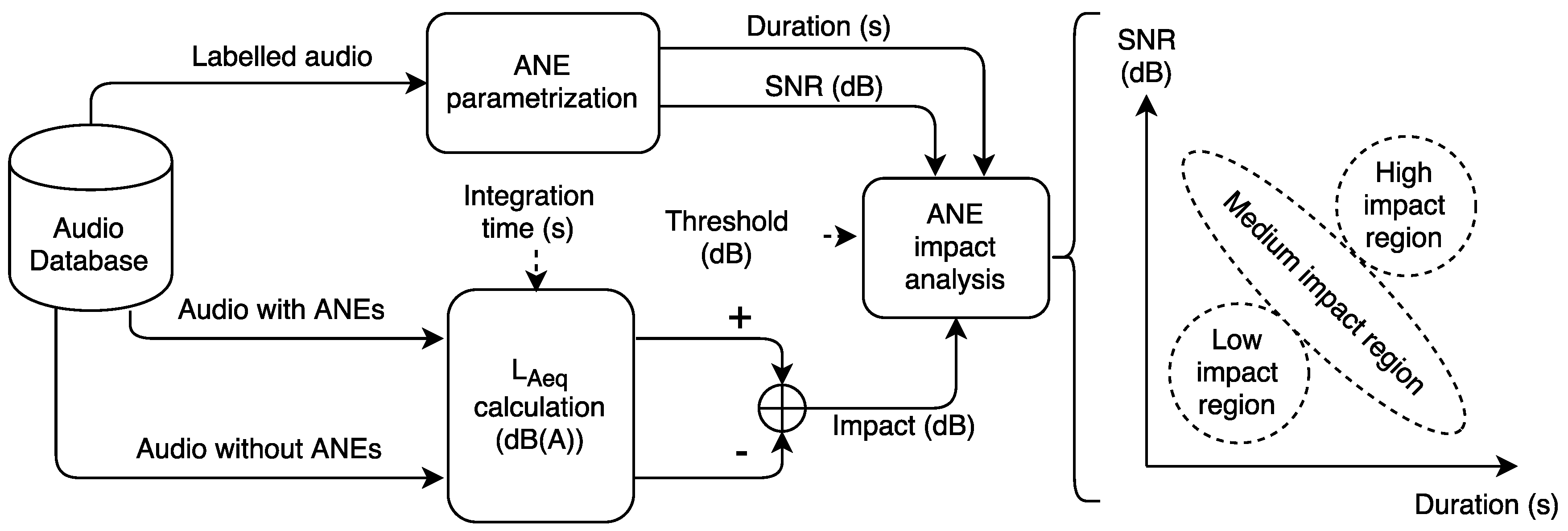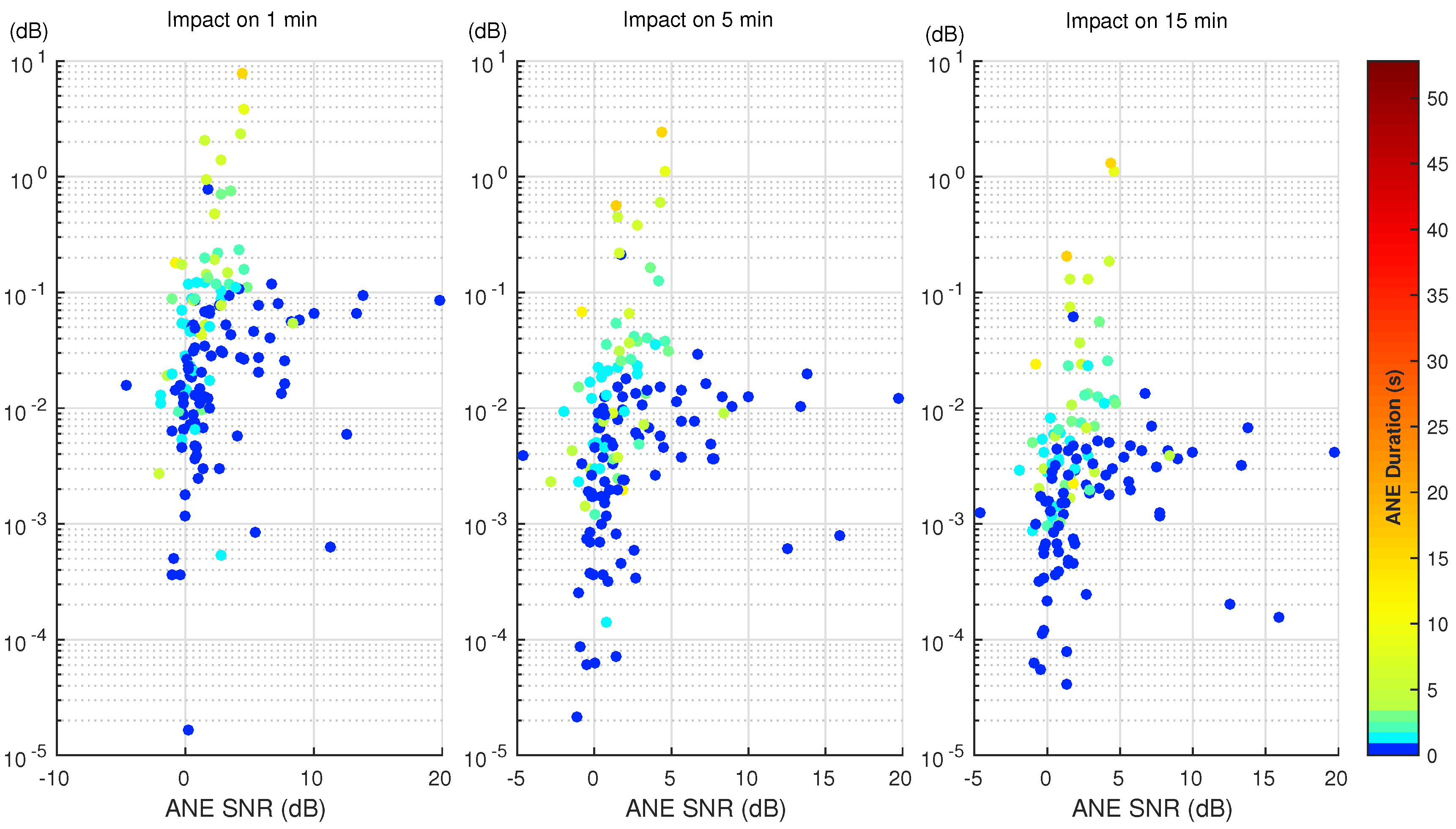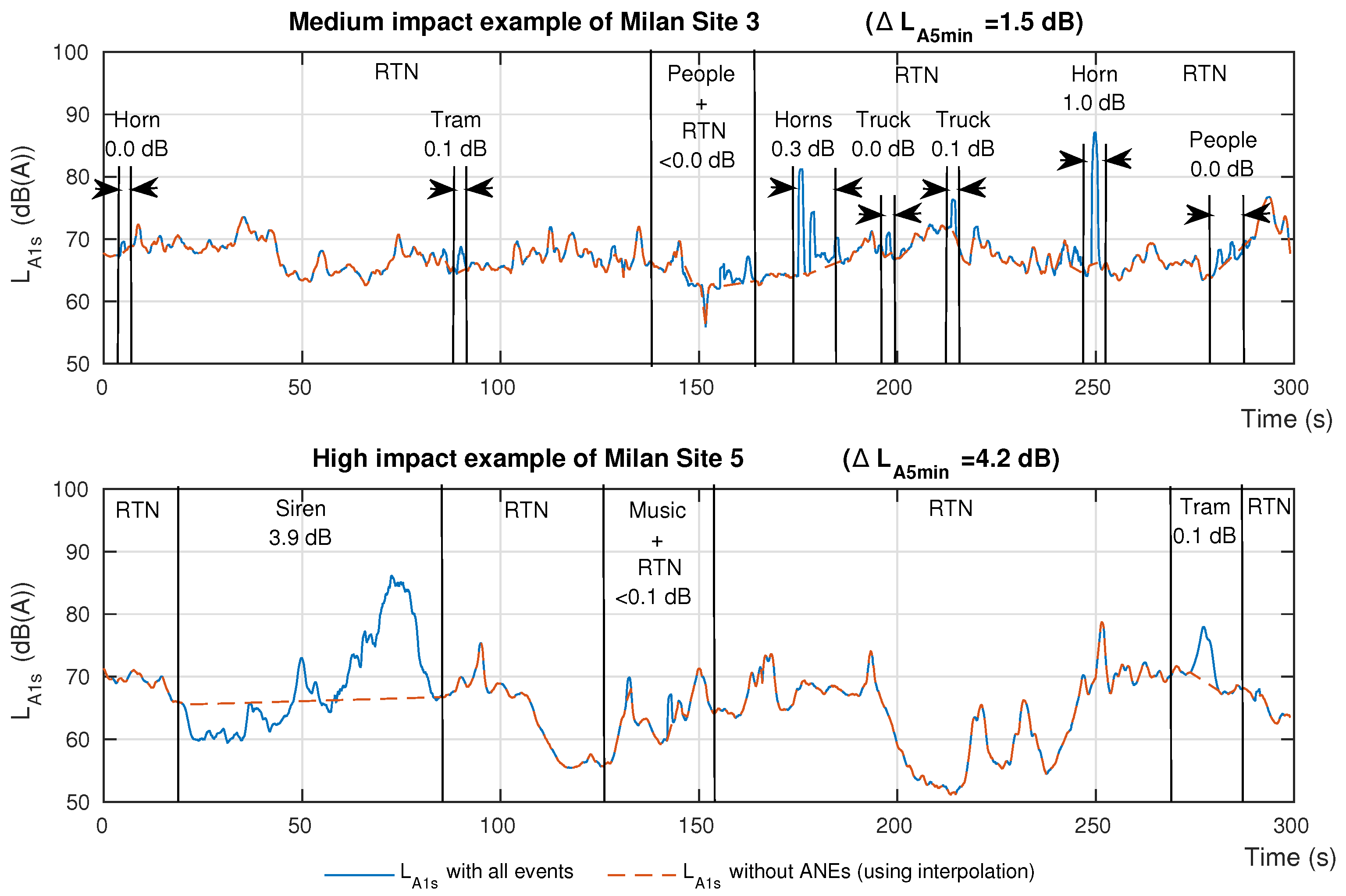On the Impact of Anomalous Noise Events on Road Traffic Noise Mapping in Urban and Suburban Environments
Abstract
:1. Introduction
2. Related Work
2.1. Influence of Noise on Public Health
2.2. Noise Monitoring
3. Analysis Methodology
3.1. ANE Parametrization
- SNR Calculation.First, the SNR of an ANE is defined as a classical Signal-to-Noise Ratio, but considering that the RTN noise is not stationary. It is evaluated in order to obtain the impact of a particular ANE in relation to the surrounding RTN signal level. The acoustic power of the ANE with respect to the surrounding RTN is calculated as expressed by Equation (1):where N is the number of samples and is the recorded audio during a certain integration period.After the powers of the ANE and the RTN are evaluated, the SNR is calculated as follows:where belongs to the anomalous event and belongs to the power of and , the former is the previous RTN to the ANE and the latter is the next portion of RTN sound.Due to the relative nature of the measure, it is worth mentioning that the SNR of the event could result in a negative value if the energy of the ANE is less than the previous and following sound. This is normally caused by events that can only be heard in moments when the road traffic noise decreases. In addition, to compute the SNR, previous and following samples to the event are considered; thus, this calculation is only meant for analysis and it is not applicable for real-time decision purposes due to the need of future samples of the signal.
- Duration of the ANE.The duration of the events is an important factor, since not only the salience of the event is important in what concerns its impact on the computation, but also the time the anomalous situation lasts. The duration of the ANE is obtained by means of the difference between the time stamp of the first and the last sample of the labelled dataset. As published in the previous study of the dataset, the duration of the ANEs may vary depending on the typology of the sound and the circumstances of the location [15]. One of the shorter samples observed corresponds to 40 ms length in Rome, and the longer 53 s in Milan, with 0.6 s being the mean of the duration of the ANE.
3.2. Impact Calculation
4. Experiments
4.1. Real-Life Dataset
4.2. Individual ANE Impact on the Computation
4.3. Aggregated Impact of All ANEs
5. Discussion
5.1. Evaluation of the Impact of ANEs on Considering Real-Life Data
5.2. Impact of the ANEs on the Population
6. Conclusions
Acknowledgments
Author Contributions
Conflicts of Interest
Abbreviations
| ANE | Anomalous Noise Event |
| CNOSSOS-EU | Common Noise Assessment Methods in Europe |
| DALYs | Disability-Adjusted Life-Years |
| END | Environmental Noise Directive |
| RTN | Road Traffic Noise |
| SNR | Signal-to-Noise Ratio |
| WASN | Wireless Acoustic Sensor Networks |
| WHO | World Health Organization |
References
- Goines, L.; Hagler, L. Noise pollution: A modern plague. South. Med. J. 2007, 100, 287–294. [Google Scholar] [CrossRef] [PubMed]
- Stansfeld, S.A.; Matheson, M.P. Noise pollution: Non-auditory effects on health. Br. Med. Bull. 2003, 68, 243–257. [Google Scholar] [CrossRef] [PubMed]
- Babisch, W. Transportation noise and cardiovascular risk. Noise Health 2008, 10, 27–33. [Google Scholar] [CrossRef] [PubMed]
- Regecová, V.; Kellerová, E. Effects of urban noise pollution on blood pressure and heart rate in preschool children. J. Hypertens. 1995, 13, 405–412. [Google Scholar] [CrossRef] [PubMed]
- Öhrström, E.; Skånberg, A.; Svensson, H.; Gidlöf-Gunnarsson, A. Effects of road traffic noise and the benefit of access to quietness. J. Sound Vib. 2006, 295, 40–59. [Google Scholar] [CrossRef]
- Botteldooren, D.; Dekoninck, L.; Gillis, D. The influence of traffic noise on appreciation of the living quality of a neighborhood. Int. J. Environ. Res. Public Health 2011, 8, 777–798. [Google Scholar] [CrossRef] [PubMed] [Green Version]
- Jakovljevic, B.; Paunovic, K.; Belojevic, G. Road-traffic noise and factors influencing noise annoyance in an urban population. Environ. Int. 2009, 35, 552–556. [Google Scholar] [CrossRef] [PubMed]
- EUR-Lex. Directive 2002/49/EC of the European Parliament and the Council of 25 June 2002 relating to the assessment and management of environmental noise. Off. J. Eur. Communities 2002, L 189/12, 12–26. [Google Scholar]
- Kephalopoulos, S.; Paviotti, M.; Ledee, F.A. Common noise assessment methods in Europe (CNOSSOS-EU); Publications Office of the European Union: Brussels, Belgium, 2012. [Google Scholar]
- Camps, J. Barcelona noise monitoring network. In Proceedings of the Euronoise, Maastricht, Netherlands, 31 May–3 June 2015; pp. 218–220. [Google Scholar]
- Nencini, L.; De Rosa, P.; Ascari, E.; Vinci, B.; Alexeeva, N. SENSEable Pisa: A wireless sensor network for real-time noise mapping. In Proceedings of the EURONOISE, Prague, Czech Republic, 10–13 June 2012; pp. 10–13. [Google Scholar]
- De Coensel, B.; Botteldooren, D. Smart sound monitoring for sound event detection and characterization. In Proceedings of the 43rd International Congress on Noise Control Engineering (Inter-Noise 2014), Ghent University, Gent, Belgium, 16–19 November 2014. [Google Scholar]
- Sevillano, X.; Socoró, J.C.; Alías, F.; Bellucci, P.; Peruzzi, L.; Radaelli, S.; Coppi, P.; Nencini, L.; Cerniglia, A.; Bisceglie, A.; et al. DYNAMAP—Development of low cost sensors networks for real time noise mapping. Noise Mapp. 2016, 3, 172–189. [Google Scholar] [CrossRef]
- Socoró, J.C.; Alías, F.; Alsina-Pagès, R.M. An Anomalous Noise Events Detector for Dynamic Road Traffic Noise Mapping in Real-Life Urban and Suburban Environments. Sensors 2017, 17, 2323. [Google Scholar] [CrossRef] [PubMed]
- Alías, F.; Socoró, J.C. Description of anomalous noise events for reliable dynamic traffic noise mapping in real-life urban and suburban soundscapes. Appl. Sci. 2017, 7, 146. [Google Scholar] [CrossRef]
- Tsai, K.T.; Lin, M.D.; Chen, Y.H. Noise mapping in urban environments: A Taiwan study. Appl. Acoust. 2009, 70, 964–972. [Google Scholar] [CrossRef]
- Zannin, P.H.T.; Diniz, F.B.; Barbosa, W.A. Environmental noise pollution in the city of Curitiba, Brazil. Appl. Acoust. 2002, 63, 351–358. [Google Scholar] [CrossRef]
- Morillas, J.B.; Escobar, V.G.; Sierra, J.M.; Gómez, R.V.; Carmona, J.T. An environmental noise study in the city of Cáceres, Spain. Appl. Acoust. 2002, 63, 1061–1070. [Google Scholar] [CrossRef]
- Chakrabarty, D.; Chandra Santra, S.; Mukherjee, A.; Roy, B.; Das, P. Status of road traffic noise in Calcutta metropolis, India. J. Acoust. Soc. Am. 1997, 101, 943–949. [Google Scholar] [CrossRef]
- Brown, A.; Lam, K. Levels of ambient noise in Hong Kong. Appl. Acoust. 1987, 20, 85–100. [Google Scholar] [CrossRef]
- World Health Organization. Burden of Disease from Environmental Noise: Quantification of Healthy Life Years Lost in Europe; World Health Organization: Geneva, Switzerland, 2011; p. 126. [Google Scholar]
- Śliwińska-Kowalska, M.; Zaborowski, K. WHO Environmental Noise Guidelines for the European Region: A Systematic Review on Environmental Noise and Permanent Hearing Loss and Tinnitus. Int. J. Environ. Res. Public Health 2017, 14, 1139. [Google Scholar] [CrossRef] [PubMed]
- Nieuwenhuijsen, M.J.; Ristovska, G.; Dadvand, P. WHO Environmental Noise Guidelines for the European Region: A Systematic Review on Environmental Noise and Adverse Birth Outcomes. Int. J. Environ. Res. Public Health 2017, 14, 1252. [Google Scholar] [CrossRef] [PubMed]
- Guite, H.; Clark, C.; Ackrill, G. The impact of the physical and urban environment on mental well-being. Public Health 2006, 120, 1117–1126. [Google Scholar] [CrossRef] [PubMed]
- Sørensen, M.; Andersen, Z.J.; Nordsborg, R.B.; Becker, T.; Tjønneland, A.; Overvad, K.; Raaschou-Nielsen, O. Long-term exposure to road traffic noise and incident diabetes: A cohort study. Environ. Health Perspect. 2013, 121, 217–222. [Google Scholar] [PubMed]
- Passchier-Vermeer, W.; Passchier, W.F. Noise exposure and public health. Environ. Health Perspect. 2000, 108, 123–131. [Google Scholar] [CrossRef] [PubMed]
- Van Renterghem, T.; Botteldooren, D. Focused study on the quiet side effect in dwellings highly exposed to road traffic noise. Int. J. Environ. Res. Public Health 2012, 9, 4292–4310. [Google Scholar] [CrossRef] [PubMed] [Green Version]
- Brown, A.L.; van Kamp, I. WHO environmental noise guidelines for the European region: A systematic review of transport noise interventions and their impacts on health. Int. J. Environ. Res. Public Health 2017, 14, 873. [Google Scholar] [CrossRef] [PubMed]
- Barham, R.; Chan, M.; Cand, M. Practical experience in noise mapping with a MEMS microphone based distributed noise measurement system. In INTER-NOISE and NOISE-CON Congress and Conference Proceedings; Institute of Noise Control Engineering: Reston, VA, USA, 2010; Volume 6, pp. 4725–4733. [Google Scholar]
- Rainham, D. A wireless sensor network for urban environmental health monitoring: UrbanSense. In IOP Conference Series: Earth and Environmental Science; IOP Publishing: Bristol, UK, 2016; Volume 34. [Google Scholar]
- Bartalucci, C.; Borchi, F.; Carfagni, M.; Furferi, R.; Governi, L. Design of a prototype of a smart noise monitoring system. In Proceedings of the 24th International Congress on Sound and Vibration (ICSV24), London, UK, 23–27 July 2017. [Google Scholar]
- Gupta, S.; Ghatak, C. Environmental noise assessment and its effect on human health in an urban area. Int. J. Environ. Sci. 2011, 1, 1954–1964. [Google Scholar]
- Licitra, G.; Gallo, P.; Rossi, E.; Brambilla, G. A novel method to determine multiexposure priority indices tested for Pisa action plan. Appl. Acoust. 2011, 72, 505–510. [Google Scholar] [CrossRef]
- Miedema, H.M. Relationship between exposure to multiple noise sources and noise annoyance. J. Acoust. Soc. Am. 2004, 116, 949–957. [Google Scholar] [CrossRef] [PubMed]
- European Commission Working Group (Assessment of Exposure to Noise) Good Practice Guide for Strategic Noise Mapping and the Production of Associated Data on Noise. 2006. Available online: http://sicaweb.cedex.es/docs/documentacion/Good-Practice-Guide-for-Strategic-Noise-Mapping.pdf (Accessed on 22 December 2017).
- Liguori, C.; Ruggiero, A.; Russo, D.; Sommella, P. Estimation of the minimum measurement time interval in acoustic noise. Appl. Acoust. 2017, 127, 126–132. [Google Scholar] [CrossRef]







| Region | Scenario | Type | Signal-to-Noise Ratio (dB) | Duration (s) | (dB) |
|---|---|---|---|---|---|
| High Impact (>2dB) | Suburban | Siren | 4.4 | 16 | 2.4 |
| Urban | Train | 4.8 | 26 | 7.4 | |
| Siren | 2.2 | 50 | 3.9 | ||
| Truck | 11.0 | 17 | 3.5 | ||
| Train | 6.9 | 32 | 2.8 | ||
| Medium Impact (0.5–2 dB) | Suburban | Siren | 4.5 | 9 | 1.1 |
| Siren | 4.3 | 6 | 0.6 | ||
| Siren | 1.5 | 16 | 0.6 | ||
| Urban | Train | 13.8 | 18 | 1.9 | |
| Horn | 12.0 | 2 | 1.4 | ||
| Horn | 14.3 | 1 | 1.4 | ||
| Train | 2.6 | 7 | 1.2 | ||
| Horn | 9.6 | 1 | 1.1 | ||
| Tramway | 17.1 | 15 | 1.0 | ||
| Tramway | 12.0 | 10 | 0.8 | ||
| Tramway | 15.4 | 9 | 0.8 | ||
| Tramway | 3.8 | 6 | 0.6 | ||
| Tramway | 3.5 | 15 | 0.6 | ||
| Horn | 9.6 | 1 | 0.6 |
| Scenario | Location | (dB) | Description |
|---|---|---|---|
| Milan | Site 4 | 2.7 | Train pass-bys of 140 s in total. |
| Site 5 | 1.9 | Tramway pass-bys of 40 s in total and a 50-s high-SNR siren. | |
| Site 3 | 1.9 | Many high-SNR horns and three high-impact hitching system noises. | |
| Site 5 | 1.3 | Tramway pass-bys of 80 s in total. |
© 2017 by the authors. Licensee MDPI, Basel, Switzerland. This article is an open access article distributed under the terms and conditions of the Creative Commons Attribution (CC BY) license (http://creativecommons.org/licenses/by/4.0/).
Share and Cite
Orga, F.; Alías, F.; Alsina-Pagès, R.M. On the Impact of Anomalous Noise Events on Road Traffic Noise Mapping in Urban and Suburban Environments. Int. J. Environ. Res. Public Health 2018, 15, 13. https://doi.org/10.3390/ijerph15010013
Orga F, Alías F, Alsina-Pagès RM. On the Impact of Anomalous Noise Events on Road Traffic Noise Mapping in Urban and Suburban Environments. International Journal of Environmental Research and Public Health. 2018; 15(1):13. https://doi.org/10.3390/ijerph15010013
Chicago/Turabian StyleOrga, Ferran, Francesc Alías, and Rosa Ma Alsina-Pagès. 2018. "On the Impact of Anomalous Noise Events on Road Traffic Noise Mapping in Urban and Suburban Environments" International Journal of Environmental Research and Public Health 15, no. 1: 13. https://doi.org/10.3390/ijerph15010013







